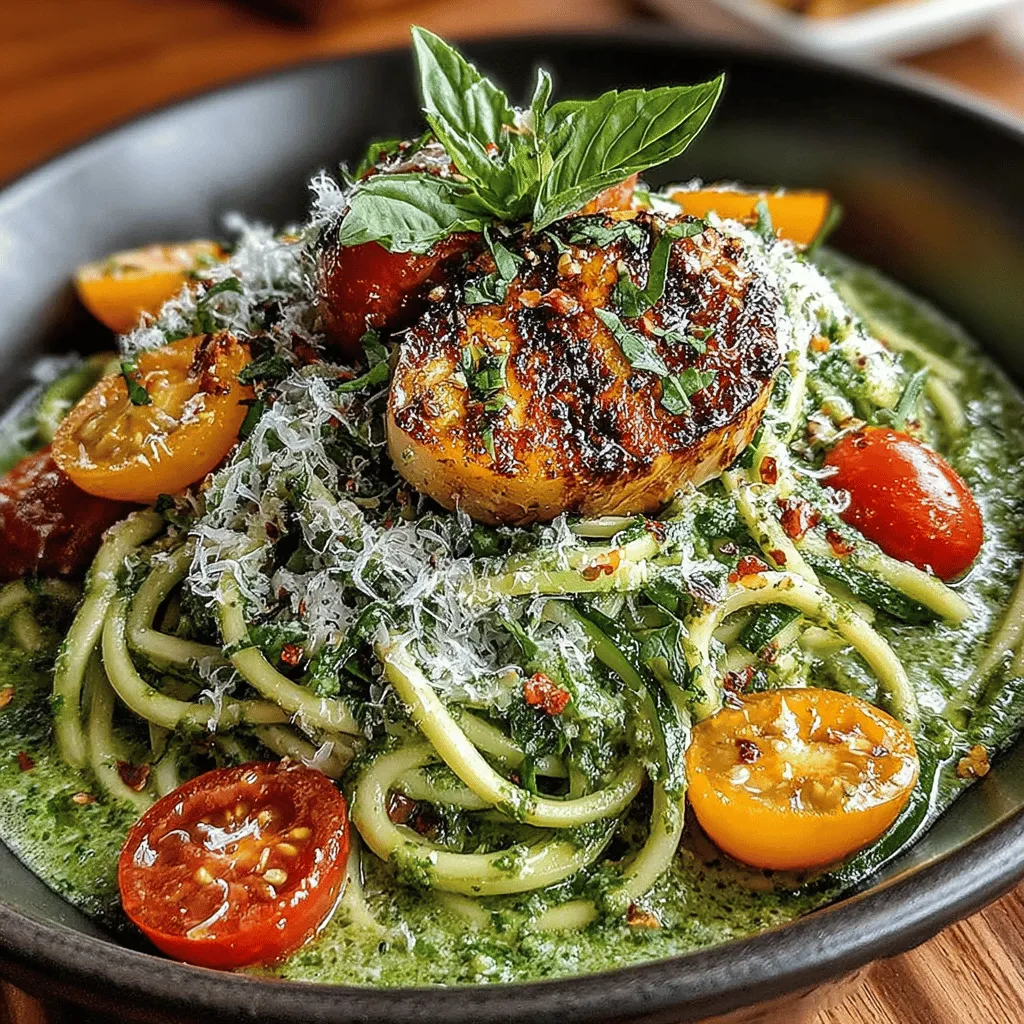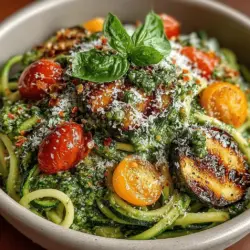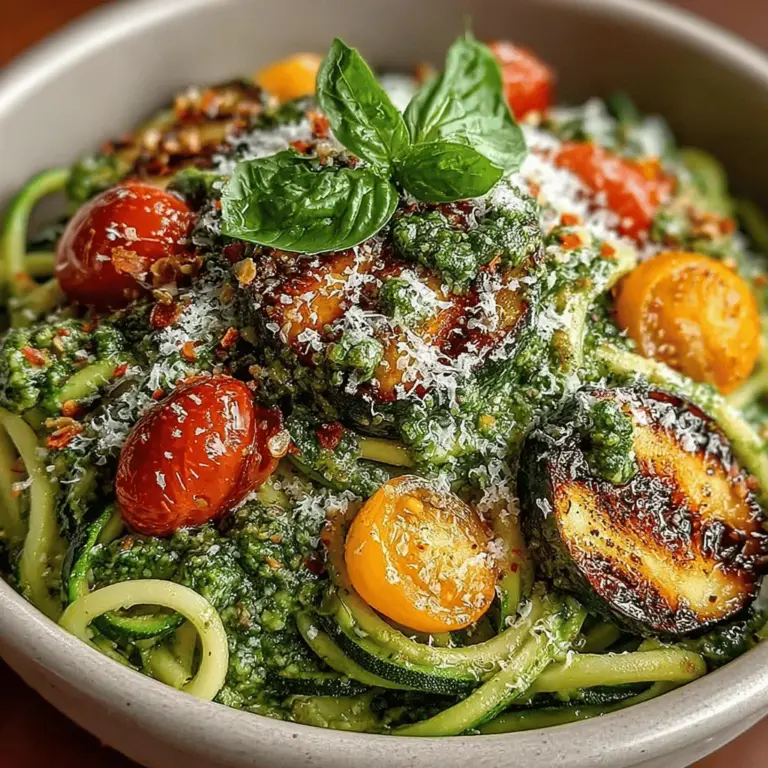Zesty Basil Pesto Zucchini Noodles: A Fresh Take on Pasta
In the world of healthy eating, zucchini noodles—or “zoodles”—have emerged as a popular alternative to traditional pasta. These ribbons of fresh zucchini offer a light, low-carb option that is not only visually appealing but also packed with nutrients. As more people turn to plant-based diets or seek to reduce their carbohydrate intake, zucchini noodles have solidified their place in the culinary landscape, making them a staple for health-conscious eaters and vegetarians alike.
At the heart of this recipe is basil pesto, a vibrant and aromatic sauce that elevates any dish it touches. Originating from the Liguria region of Italy, basil pesto is a blend of fresh basil, garlic, pine nuts, Parmesan cheese, and olive oil. This combination creates a rich, savory flavor that perfectly complements the mild taste of zucchini noodles. The marriage of zoodles and zesty basil pesto offers a fresh, light meal that is both satisfying and nourishing.
Understanding Zucchini Noodles
Zucchini noodles are created by spiralizing fresh zucchini, resulting in long, noodle-like strands that can be used in a variety of dishes. Not only do they provide a gluten-free alternative to traditional pasta, but they also come with a host of nutritional benefits. Zucchini is low in calories yet high in vitamins and minerals, including vitamin C, vitamin A, potassium, and antioxidants. This makes zoodles an excellent choice for those looking to incorporate more vegetables into their diet without sacrificing flavor or satisfaction.
Creating zucchini noodles is a straightforward process that can be accomplished with the right tools. A spiralizer is the most popular device for turning zucchini into zoodles, and these come in various styles, from handheld gadgets to larger countertop models. Each type offers unique features, so choosing one that fits your cooking style and kitchen space is essential. For those who may not have a spiralizer, a julienne peeler or a standard vegetable peeler can also produce thin strips of zucchini, though they may not achieve the same noodle-like shape.
When selecting zucchini for spiralizing, look for firm, unblemished specimens that are medium-sized. Smaller zucchinis may lack flavor, while larger ones can be overly watery and seedy. Aim for zucchinis that are about 6 to 8 inches in length. Additionally, consider choosing organic zucchinis to avoid pesticide residues and to enjoy the best flavor.
The Magic of Basil Pesto
Basil pesto is a culinary masterpiece that showcases the vibrant flavors of its ingredients. Traditionally made with fresh basil leaves, garlic, pine nuts, Parmesan cheese, and olive oil, this sauce is both versatile and easy to prepare. Each ingredient contributes to the overall taste and nutritional profile of the pesto.
– Fresh Basil: The star of the show, fresh basil provides a fragrant and slightly peppery flavor. It’s also rich in vitamins A, K, and C, as well as antioxidants that promote overall health and wellness.
– Pine Nuts: These small nuts add a delightful creaminess to the pesto while supplying healthy fats, protein, and fiber. Toasting pine nuts before adding them to the pesto enhances their flavor, bringing out a nutty richness that complements the other ingredients.
– Parmesan Cheese: A crucial element in traditional basil pesto, Parmesan cheese adds depth and umami. It is also a source of calcium and protein, making it a valuable addition to a balanced diet.
– Garlic: With its bold flavor, garlic not only adds a zesty kick to the pesto but also boasts numerous health benefits, including anti-inflammatory properties and immune system support.
– Olive Oil: The quality of olive oil can significantly impact the flavor of your pesto. Opt for extra virgin olive oil for its robust taste and health benefits, including heart-healthy monounsaturated fats.
– Lemon Juice: A splash of lemon juice brightens the pesto, providing acidity that balances the richness of the other ingredients. It also adds a dose of vitamin C and enhances the overall flavor profile.
Step-by-Step Preparation of Zesty Basil Pesto Zucchini Noodles
Now that we understand the components of our dish, let’s dive into the preparation of Zesty Basil Pesto Zucchini Noodles. The process involves two main components: creating the zucchini noodles and preparing the zesty basil pesto.
Preparing Zucchini Noodles
1. Spiralizing Zucchini: Start by washing your zucchinis thoroughly. Cut off both ends, then secure the zucchini in your spiralizer. If you’re using a handheld spiralizer, make sure to apply even pressure as you twist the zucchini to create even noodles. For countertop models, simply turn the handle while pushing the zucchini through the blades.
2. Managing Moisture: Zucchini contains a high amount of water, which can lead to a soggy dish if not handled properly. After spiralizing, place the zoodles in a colander and sprinkle them with a little salt. Allow them to sit for about 10-15 minutes to draw out excess moisture. Afterward, gently pat the noodles dry with a clean kitchen towel or paper towels.
3. Cooking the Zoodles: For a warm dish, sauté the zucchini noodles in a skillet over medium heat for 2-3 minutes. This quick cooking time will soften the zoodles while keeping them al dente. If you prefer a cold dish, you can skip this step and serve the zoodles raw, allowing their natural crunch to shine through.
Making the Zesty Basil Pesto
1. Gather Ingredients: Start with fresh basil leaves, toasted pine nuts, grated Parmesan cheese, garlic cloves, a good quality extra virgin olive oil, and fresh lemon juice.
2. Blending the Pesto: In a food processor, combine 2 cups of fresh basil leaves, 1/4 cup of toasted pine nuts, 1/2 cup of grated Parmesan cheese, and 2-3 garlic cloves (adjust based on your taste preference). Pulse the mixture a few times to break down the ingredients.
3. Incorporating Olive Oil: While the food processor is running, slowly drizzle in 1/2 cup of extra virgin olive oil until the pesto reaches your desired consistency. If you prefer a thinner pesto, you can add more olive oil or a splash of water.
4. Finishing Touches: Add the juice of half a lemon, along with salt and pepper to taste. Pulse again to combine, ensuring all ingredients are well incorporated and the pesto is smooth but still has some texture.
With the zoodles prepared and the zesty basil pesto ready to go, you’re well on your way to creating a delicious and healthy meal. Whether you’re serving it as a light lunch, a side dish, or a main course, Zesty Basil Pesto Zucchini Noodles are a delightful way to enjoy the flavors of summer while maximizing nutrition. Stay tuned for the next part of this article, where we will explore additional serving suggestions and variations to enhance this vibrant dish!

Equipment Needed
To create the best Zesty Basil Pesto Zucchini Noodles, you’ll need a few essential kitchen tools. These will help streamline the process and ensure that you achieve the perfect consistency and flavor for your dish.
– Food Processor: This is crucial for blending the pesto ingredients into a smooth, creamy sauce. A high-quality food processor will make the task quicker and easier.
– Spiralizer: If you’re looking to create perfect zucchini noodles, a spiralizer is a must-have. It transforms fresh zucchini into long, curly noodles that mimic traditional pasta.
– Measuring Cups and Spoons: Precise measurements ensure that your pesto is well-balanced in flavor, making measuring cups and spoons essential.
– Cutting Board and Knife: For prepping your ingredients, including chopping the garlic and basil, a sturdy cutting board and a sharp knife will make your prep work easier and more efficient.
Measuring and Combining Ingredients for Optimal Flavor
The secret to a delicious pesto lies in the right balance of ingredients. Here’s how to measure and combine them effectively:
1. Fresh Basil: Use about 2 cups of tightly packed fresh basil leaves. This is the star of the dish and provides that quintessential aromatic flavor.
2. Nuts: Pine nuts are traditional for pesto, but you can use walnuts or cashews for a twist. Measure out ¼ cup of nuts, lightly toasted to enhance their flavor.
3. Garlic: A clove or two of garlic adds depth to your pesto. Aim for 1-2 cloves, peeled and roughly chopped to facilitate blending.
4. Parmesan Cheese: Use ½ cup of grated Parmesan cheese. For a vegan option, try nutritional yeast instead.
5. Olive Oil: Start with about ½ cup of extra virgin olive oil. This ingredient will help achieve the desired consistency. You can adjust this amount based on how thick or thin you want your pesto.
6. Seasoning: A pinch of salt and pepper will enhance the overall flavor. You can always add more after tasting the blended mixture.
Adjusting Consistency and Flavor
As you prepare the pesto, you may find that you need to adjust the consistency and flavor. Here’s how to do it:
– To Thicken the Pesto: If your pesto is too thin, add more basil or nuts to thicken it. You can also incorporate more cheese for a creamier texture.
– To Thin the Pesto: If the pesto is too thick, drizzle in more olive oil, one tablespoon at a time, until it reaches your desired consistency.
– Flavor Adjustments: Tasting as you go is essential. If you feel the pesto needs a boost, consider adding more garlic, a squeeze of lemon juice for brightness, or a touch more salt to enhance the overall flavor.
Combining the Two Components
Once your pesto is ready, it’s time to combine it with the zucchini noodles. Here’s how to ensure an even coating:
1. Prepare the Zucchini Noodles: Using your spiralizer, create your zoodles and place them in a large mixing bowl.
2. Heat the Zoodles: If you prefer warm noodles, you can sauté the zucchini noodles in a non-stick skillet over medium heat for 2-3 minutes until slightly softened. Avoid overcooking, as they can become mushy.
3. Mix in the Pesto: Add a generous scoop of pesto to the zoodles. Use tongs or a large fork to gently toss the noodles and pesto together. The goal is to coat every strand evenly without breaking the zoodles.
Serving Suggestions and Variations
Presentation is key when serving Zesty Basil Pesto Zucchini Noodles. Here are some ideas to elevate your dish:
Presentation Ideas for Serving Zoodles with Pesto
– Plates vs. Bowls: For a more elegant presentation, use flat plates. This allows the zoodles to spread out, showcasing the vibrant green color of the pesto. If you’re serving a hearty portion or adding toppings, bowls can help contain everything neatly.
– Garnishing Tips: Enhance your dish’s visual appeal by garnishing with halved cherry tomatoes and fresh basil leaves. The bright red of the tomatoes against the green of the pesto will create a stunning contrast, while the basil adds a pop of color.
Creative Variations to the Basic Recipe
For those looking to customize their Zesty Basil Pesto Zucchini Noodles, consider the following variations:
– Adding Proteins: Boost the protein content of your meal by adding grilled chicken, sautéed shrimp, or roasted chickpeas. These additions will make the dish more filling and satisfying.
– Incorporating Other Vegetables: Mix in other veggies like bell peppers, spinach, or roasted asparagus for added nutrition and flavor diversity. They will complement the zoodles and pesto beautifully.
– Exploring Alternative Nuts or Cheeses: While traditional pesto uses pine nuts and Parmesan, feel free to experiment with walnuts or hazelnuts and feta or nutritional yeast for a unique twist.
Nutritional Information
Understanding the nutritional profile of Zesty Basil Pesto Zucchini Noodles can help you appreciate its health benefits:
– Calories: Approximately 200 calories per serving, depending on the amount of pesto used and any added protein.
– Fats: Around 15 grams of healthy fats mainly from olive oil and nuts, which promote heart health.
– Proteins: If you choose to add proteins like chicken or chickpeas, the protein content can increase significantly, making it a complete meal.
– Carbohydrates: Zucchini noodles are low in carbs, typically containing about 6 grams per serving, making this dish an excellent option for those following a low-carb or ketogenic diet.
Discussion on the Health Benefits of the Dish
– Low-Carb Aspects of Zucchini Noodles: Zucchini serves as a fantastic alternative to traditional pasta, significantly reducing carbohydrate intake while providing a satisfying texture.
– Nutrient Density of Fresh Ingredients: The fresh basil, garlic, and olive oil contribute essential nutrients, antioxidants, and healthy fats, making this dish not only tasty but also nourishing.
Conclusion
Zesty Basil Pesto Zucchini Noodles are more than just a meal; they are a delightful exploration of fresh flavors and healthy ingredients. This dish stands out as a delicious and healthy option for anyone looking to incorporate more vegetables into their diet. The versatility of zucchini and pesto allows for endless creativity, enabling you to tailor the dish to your taste preferences and nutritional needs.
Embrace the opportunity to experiment with various ingredients and presentation styles, ensuring that every meal is unique and exciting. Incorporating more fresh ingredients into your daily meals will not only enhance your culinary skills but also promote better health and enjoyment. So grab your spiralizer and food processor, and get ready to create a dish that will impress your family and friends alike!

